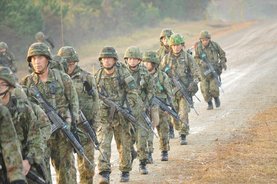 Source: @japan_jsdf
Source: @japan_jsdf It is the culmination of at least a decade of negotiations and agreements made between Japan and Australia that stretch back to the security cooperation agreement reached between PM Abe (in his first crack at that position) and PM Howard in 2007. It is also in keeping with the growing defence arrangements that both countries have set in place as a hedging policy against uncertainty. As of now, Australia has an annual prime ministerial meeting with Japan, an annual 2+2 meeting between the Japanese and Australian foreign and defence ministers, an acquisition and cross servicing agreement with Japan (updated during last year’s visit to Sydney by PM Abe), and an information sharing agreement with Japan (not to mention the annual defence exercises of Southern Jackaroo and Nichigo Trident).
The addition of a VFA to these measures will expand the scope of cooperation between both sides and ultimately define the manner by which the SDF and ADF will operate with one another in the future. It will reinforce the idea in Japanese defence circles of Australia as a ‘quasi-ally’, for no other country apart from the US has developed such progressive, broad-reaching ties with the SDF. For Japan, the possibility of undertaking more extensive military exercises with Australia is an attractive prospect for a country that lacks the space to be able to conduct exercises on the scale of those in Australia. It will increase the level of awareness in the defence forces of either country of the operating procedures and military culture of their Japanese and Australian counterparts, and add to the value of both to the US military presence in the Indo-Pacific.
The gradual implementation of the VFA will inevitably lead to criticism that it is provocative towards China, that Australia is hostile to China’s presence in the region and that it is seeking to exploit this with Japan in order to contain China’s “rise”. Yet the agreement, rather than being a knee-jerk reaction to China’s increased belligerence, has been in the works for years, and is more the culmination of a gradual move towards inter-regional defence support than a straight out backlash against Chinese military expansion.
The next step in the progress of Japan-Australia defence ties will be defence technology sharing, which has a precedent in the recent agreement Japan made with the UK to undertake joint research on a missile project. Whether Australia reaches the same level of cooperation depends on what we have to offer, although Australia’s use of upgraded CEA phased array radar systems on its new AWDs and its decision to install the Aegis system on its (soon to be announced) future frigates are certainly of interest to Japan and two areas that both countries could jointly explore.
In the meantime both PMs will be devoting their attention to how to get momentum on the TPP moving forward after the hiccup of last year’s APEC meeting in Vietnam. Both countries poured their diplomatic resources into getting a TPP 11 agreement confirmed, only to be disrupted at the last hurdle by a disgruntled Canada. With Davos coming up shortly, PM Turnbull will be keen to know what PM Abe believes will be achieved at this year’s trade meeting, and where he sees the course of trade relations going in the Indo-Pacific.
So it will be a short visit, but one of much promise for bilateral relations for the remainder of 2018. At the very least, it will occur at a time of relatively low domestic political activity in both countries, so it should garner some interest from the press. Only time will tell when the agreement will finally be signed, but all indications are that both governments want this document in place ASAP, and so expect another announcement at some point in the very near distant future.
 RSS Feed
RSS Feed